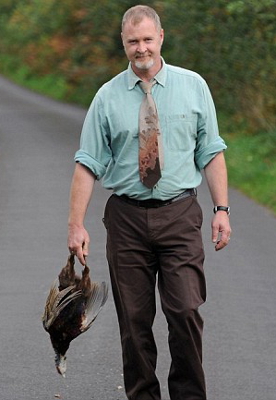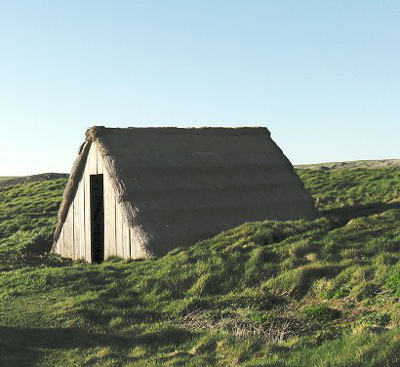
Outside-the-box meat consumption
 Some of my favorite parts of Unlearn, Rewild
are the chapters on meat, which present very outside-the-box
thinking. Miles Olson was once a vegan, but he experienced a
journey similar to mine and Mark's --- as he got closer to nature, he
realized it made more sense to eat meat. That's where our paths
diverged from Olson's, though, since Mark and I got into pasturing
livestock and Olson got into...figuring out when roadkill is safe to
consume.
Some of my favorite parts of Unlearn, Rewild
are the chapters on meat, which present very outside-the-box
thinking. Miles Olson was once a vegan, but he experienced a
journey similar to mine and Mark's --- as he got closer to nature, he
realized it made more sense to eat meat. That's where our paths
diverged from Olson's, though, since Mark and I got into pasturing
livestock and Olson got into...figuring out when roadkill is safe to
consume.
Ever wonder if that deer
by the side of the road is delectable meat going to waste, or is a case
of food poisoning in disguise? Olson provides these tips for when
to snag the carcass and when to leave it lying:
- If the hair pulls out easily when you tug on it, the meat is old and might not be safe.
- Clouded-over eyes are another indication of age.
- Rigor mortis is actually a sign of relatively fresh meat since the stiffness only lasts for a day or less.
- Big maggots are a sign of old meat. In addition, maggots
will pre-digest your meat, changing the flavor (but not necessarily
making it unsafe to eat).
- If it's cold outside, the meat is probably safer than if you found the deer on a scorching summer day.
- Smaller critters (like rabbits) actually keep better than big animals (like deer) because their guts are smaller and less prone to rupturing and sullying the meat.
Assuming you followed
Olson's advice and decided the deer by the side of the road was safe to
eat, what's next? Olson provided some tips we can all benefit from
about aging meat, a process that makes meat more tender. He
explains that the biggest danger in aging meat is promoting anaerobic
conditions, often found in meat in air-tight containers and in ground
meat. Excess moisture also makes meat rot instead of age.
Olson suggests a couple of different ways to age meat safely, one of
which is the traditional above-ground technique of hanging the meat in a
well-ventilated area away from flies. The other is to emulate
dogs and bury meat at least a foot deep to age the flesh slowly
underground. It's handy to know that in a survival situation, if I
killed a deer and had no refrigerator, I could bury big pieces of meat
and eat them safely weeks later.
After aging, you'd think
the next step would be cooking, but Olson actually eats most of his meat
raw to prevent the formation of carcinogens during high-temperature
cooking. Parasites can be a problem with raw meat (especially if
you're eating omnivores instead of herbivores), but Olson explains that
freezing meat for two weeks kills most parasites. Of course, you
can also cook the meat to destroy most parasites and diseases (short of
chronic wasting disease).
 Rather
than cooking, Olson dries most of his meat. Although many
traditional cultures smoke meat as they dry it, Olson is concerned about
the carcinogenic nature of creosote, so he usually dries his meat
smoke-free. He explains that if you put meat in a well-ventilated,
stone hut in a windy place, the food can dry due to the action of wind
alone, and I wonder whether you could create your own wind by making a
black chimney rise out of a well-ventilated room (similar to the
technique some people use to make smells from composting toilets move up
and out of human range). Or you can simply dry your meat the same
way you would other foods or clothes --- in a sunny spot away from
flies, or in the warm area above your wood stove.
Rather
than cooking, Olson dries most of his meat. Although many
traditional cultures smoke meat as they dry it, Olson is concerned about
the carcinogenic nature of creosote, so he usually dries his meat
smoke-free. He explains that if you put meat in a well-ventilated,
stone hut in a windy place, the food can dry due to the action of wind
alone, and I wonder whether you could create your own wind by making a
black chimney rise out of a well-ventilated room (similar to the
technique some people use to make smells from composting toilets move up
and out of human range). Or you can simply dry your meat the same
way you would other foods or clothes --- in a sunny spot away from
flies, or in the warm area above your wood stove.
As a final note on
alternative meat-eating, Olson does suggest eating some parts of the
animal that most of us probably eschew. He says that livers,
lungs, eyeballs, blood, and the fat around the organs of herbivores are
all excellent dried. In general, high-value meats that we often
ignore include adrenal glands (high in vitamin
C), eyes (high in zinc), bones and soft, velvet antlers (mineral-rich
fat), brains, pancreas (high in vitamin K2, which prevents tooth decay),
and testicles.
Now, wasn't that a great appetizer for lunch?
| This post is part of our Unlearn, Rewild lunchtime series.
Read all of the entries: |
Want more in-depth information? Browse through our books.
Or explore more posts by date or by subject.
About us: Anna Hess and Mark Hamilton spent over a decade living self-sufficiently in the mountains of Virginia before moving north to start over from scratch in the foothills of Ohio. They've experimented with permaculture, no-till gardening, trailersteading, home-based microbusinesses and much more, writing about their adventures in both blogs and books.
Want to be notified when new comments are posted on this page? Click on the RSS button after you add a comment to subscribe to the comment feed, or simply check the box beside "email replies to me" while writing your comment.

Honestly, was all that less work than raising chickens or rabbits?
Talking of "Outside the box meat" I'm reminded of when my mom's dad took my dad's brother hunting for squirrels. My mountain man grandfather built a fire in the woods to cook them, and placed the heads IN the fire. My uncle said that when the brain boiled to a certain point the skulls cracked open. Then my grandfather did what his dad and grandad had always done: once everything was cool enough, he ate the squirrel brains with a spoon out of the skulls.
So my navy-brat uncle said now he would rather starve to death in a forest full of squirrels. XD